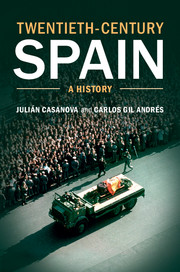Book contents
- Frontmatter
- Contents
- List of illustrations
- Key figures
- List of abbreviations
- Twentieth-century Spain timeline
- Maps
- Introduction
- Part I The monarchy of Alfonso XIII
- Part II The Second Republic
- Part III The Civil War
- Part IV Franco’s dictatorship
- Part V Transition and democracy
- 13 The Transition
- 14 Democracy
- Conclusion: the balance sheet of a century
- Guide to further reading
- Index of names and authors
Conclusion: the balance sheet of a century
Published online by Cambridge University Press: 05 July 2014
- Frontmatter
- Contents
- List of illustrations
- Key figures
- List of abbreviations
- Twentieth-century Spain timeline
- Maps
- Introduction
- Part I The monarchy of Alfonso XIII
- Part II The Second Republic
- Part III The Civil War
- Part IV Franco’s dictatorship
- Part V Transition and democracy
- 13 The Transition
- 14 Democracy
- Conclusion: the balance sheet of a century
- Guide to further reading
- Index of names and authors
Summary
The twentieth century in Spain was exceptionally varied. Many Spaniards were born during a monarchy, that of Alfonso XIII, lived through two dictatorships, a republic and a civil war, and died with the grandson of Alfonso XIII, Juan Carlos I, as head of state. But their experiences were very different depending on whether they had always supported traditional order, won the war and lived quietly and contentedly during the dictatorship of their Caudillo; as opposed to those of another type of Spaniard, one who dreamt of the Republic, saw it come to fruition, fought for it until he was defeated, and never knew peace under Franco.
However, it is not the historian’s job to choose the part of the film that suits him best. The twentieth century ended in a better state than when it began, and Spain in 2000 was a much more prosperous, democratic and less violent country than in the middle decades of the century, although any satisfactory balance sheet would also need to look at the misery and fear that was left behind on the way. For the historian taking stock, the twentieth century is a complete unit, and the history of Spain cannot be separated from that of the rest of Europe.
- Type
- Chapter
- Information
- Twentieth-Century SpainA History, pp. 355 - 359Publisher: Cambridge University PressPrint publication year: 2014

